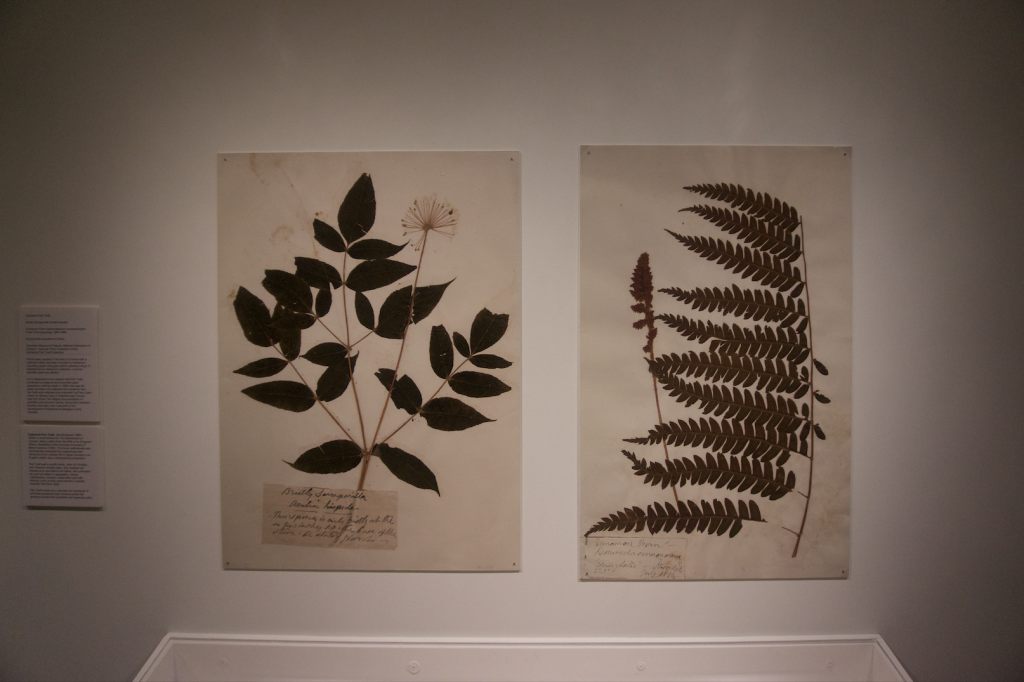Women botanists recognized in art exhibition
By Ruth Tecle
The worlds of art and science are bridged in a current Carleton University Art Gallery exhibition that highlights the hidden history of Canadian women in the field of botany.
The exhibition is named HERbarium, a gendered nod to the term’s technical meaning — a collection of dried plant specimens preserved for scientific study. Botany was the first natural science formally practiced by Canadian women, who began contributing knowledge to the field in the 19th century.
The exhibit runs until Dec. 3.
Fiona Wright, the gallery’s public programs coordinator, highlighted the historical association between botany and women’s work in turn-of-the-century Canadian society as she led a guided tour of the exhibit for the Ottawa Society of Botanical Artists on Nov. 10.
“Botany and the natural sciences has a history of being associated with women’s work,” said Wright. “It was deemed appropriate for middle-upper class ladies at the time to be interested in flowers and plant life.” The women featured in the exhibit took advantage of the space they were allowed and the domestic role women in Canadian society were expected to fulfill.
HERbarium was curated by a group of six students enrolled in a Carleton University seminar called “Representations of Women’s Scientific Contributions” taught by Cindy Stelmackowich of the Centretown-based arts collective Enriched Bread Artists.
The students — Josie Arruejo, Chelsea Black, James Botte, Brigid Christison, Michelle Jackson and Sharon Odell — combed through botanical collections housed in various institutions across Ottawa to select artifacts for display.
By digging through archived material at the Canada Science and Technology Museum, Central Experimental Farm and the Canadian Museum of Nature, the students were able to identify specimens collected local women more than a century ago.
“They went through collections that never see the light of day,” said Wright.
The curators unearthed work by five women whom they considered notable contributors to Canadian botany: Catharine Parr Traill, Lady Dalhousie, Faith Fyles, Dr. Irene Mounce and Dr. Mildred Nobles.
Fyles is known as the first woman hired by the federal government as a botanist. The work chosen for HERbarium is from her time with the horticulture division of Canada’s agriculture department. The Central Experimental Farm was working on a project to breed new types of apples that would grow well in a Canadian climate. She contributed to the scientific accuracy of the project by providing realistic illustrations of apple specimens.
“She’s captured the characteristics,” said Peg Duncan, from the Ottawa Society of Botanical Artists.
Parr Traill’s herbarium collection is distinguished for its consistent and meticulous dedication to exact labels. Her system for preserving plant specimens served as a manual and educational tool. Due to her contributions to science, including herbarium collected at 94-years-old, present-day botanists can return to the region Parr Traill studied and track any changes from the 1800s.
Parr Traill was required to pre-sell all 500 copies of her book “Canadian Wild Flower.” Despite challenges, the book was published in 1868 and has endured over time. A 2003 reprint by Lee Valley Farms was included as reference material for visitors of HERbarium.
Publishers weren’t the only barriers to early women botanists. An official but unadvertised policy prohibited married women from working for the federal government.
It was “secretive but well-known among society,” said Wright, regarding the policy’s pervasiveness. Among the curated pieces in the exhibit is an enlarged copy of a 1920s Privy Council memo outlining the policy.

